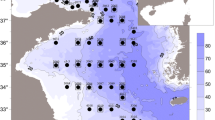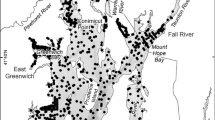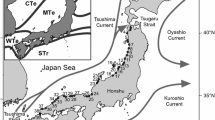Abstract
An attempt was made to identify the causes of the distribution of benthos within Bedeque Bay using multivariate techniques programmed for the computer. Both classification by a hierarchical cluster analysis, and ordination by principal components analysis suggested that a large proportion of the variance in the data was directly or indirectly correlated with a salinity gradient. Classification divided the species into two main groups, a in the upper half of the estuary where lower salinities and larger salinity fluctuations occurred, and group b in the lower half of the estuary with a more stable salinity regime. The group b species were further subdivided into those preferring soft mud and those preferring sandier sediments. The group a species were divided into a well-developed oyster association and various sub-groups less strongly associated with oysters. Five principal components were required to account for 50% of the variance in the data. The first axis accounted for 20% of the variance and was shown by a non-parametric test to be correlated with the salinity gradient. Axes II to V could not be interpreted, but possibly represented complex species interactions. By providing hard substrates and altering the natura of the sediment, oysters and mussels produced conditions suitable for many other species.
Similar content being viewed by others
Literature cited
Brett, C. E.: A portable diver-operated dredge sieve for sampling sub-tidal macrofauna. J. mar. Res. 22, 205–209 (1964).
Cassie, R. M. and [A. D. Michael: Fauna and sediments of an intertidal mud flat: a multivariate analysis. J. exp. mar. Biol. Ecol. 2, 1–23 (1968).
Day, J. H., J. G. Field and [M. Montgomery: The use of numerical methods to determine the distribution of the benthic fauna across the continental shelf of North Carolina. J. Anim. Ecol. 40, 93–125 (1971).
Field, J. G. and [G. McFarlane: Numerical methods in marine ecology. I. A quantitative “similarity” analysis of rocky shore samples in False Bay, South Africa. Zool. Afr. 3, 119–137 (1968).
— and [F. T. Robb: Numerical methods in marine ecology. 2. Gradient analysis of rocky shore samples from False Bay Zool. Afr. 5, 191–210 (1970).
Hughes, R. N. and M. L. H. Thomas: The classification and ordination of shallow-water benthic samples from Prince Edward Island, Canada. J. exp. mar. Biol. Ecol. (In press).
Lie, U. and [J. C. Kelley: Benthic infauna communites off the coast of Washington and in Puget Sound: Identification and distribution of the communities. J. Fish. Res. Bd Can. 27, 621–641 (1970).
Nichols, F. H.: Benthic polychaete assemblages and their relationship to the sediment in Port Madison, Washington. Mar. Biol. 6, 48–57 (1970).
Orloci, L.: An agglomerative method for classification of plant communities. J. Ecol. 55, 193–206 (1967a).
—: Data centering: a review and evaluation with reference to component analysis. Syst. Zool. 16, 208–212 (1967b).
Pettibone, M. H.: Marine polychaete worms of the New England region, Part 1, families Aphroditidae through Trochochaetidae. Bull. U.S. natn. Mus. 127, 1–356 (1963).
Seal, H. L.: Multivariate statistical analysis for biologists, 207 pp. London: Methuen 1964.
Smith, R. I. (Ed.): Keys to marine invertebrates of the Woods Hole region. Contr. 11, Systs Ecol. Progr., mar. biol. Lab. Woods Hole 1–208 (1964).
Swan, J. M. A.: An examination of some ordination problems by use of simulated vegetational data. Ecology 51, 89–102 (1970).
Author information
Authors and Affiliations
Additional information
Communicated by J. H. S. Blaxter, Oban
Rights and permissions
About this article
Cite this article
Hughes, R.N., Thomas, M.L.H. Classification and ordination of benthic samples from Bedeque Bay, an estuary in Prince Edward Island, Canada. Marine Biology 10, 227–235 (1971). https://doi.org/10.1007/BF00352811
Accepted:
Issue Date:
DOI: https://doi.org/10.1007/BF00352811




